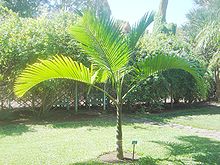Hyophorbe
| Hyophorbe | |
|---|---|

| |
| Hyophorbe indica | |
| Scientific classification | |
| Kingdom: | Plantae |
| Clade: | Tracheophytes |
| Clade: | Angiosperms |
| Clade: | Monocots |
| Clade: | Commelinids |
| Order: | Arecales |
| Family: | Arecaceae |
| Subfamily: | Arecoideae
|
| Tribe: | Chamaedoreeae |
| Genus: | Hyophorbe Gaertn. |
| Synonyms[1] | |
| |
Hyophorbe is a genus of five known species of flowering plants in the family Arecaceae, native to the Mascarene Islands in the Indian Ocean. All five species can attain heights of over 6 meters, and two of the species develop swollen trunks that have made them popular as ornamentals,[1][2] but all of them are endangered in the wild.
It contains the following species:[1]
- Hyophorbe amaricaulis Mart. – Mauritius, 1 individual left
- Hyophorbe indica Gaertn. (palmiste poison) – Réunion
- Hyophorbe lagenicaulis (L.H.Bailey) H.E.Moore (bottle palm) – Mauritius
- Hyophorbe vaughanii L.H.Bailey – Mauritius
- Rodrigues Island
Species gallery
Source:[3]
-
The last surviving specimen of Hyophorbe amaricaulis. This species has a slender, unswollen trunk.
-
Hyophorbe indica is another slender-trunk species, but often with yellow veins along its foliage.
-
Hyophorbe lagenicaulis is known as the "bottle palm" as it trunks swells from near the base, into a bottle shape.
-
Hyophorbe verschaffeltii is known as the "spindle palm" as its trunk swells in the middle. It has black fruits and yellow-green foliage.
References
Wikimedia Commons has media related to Hyophorbe.
- ^ a b c World Checklist of Selected Plant Families: Hyophorbe
- ^ Govaerts, R. & Dransfield, J. (2005). World Checklist of Palms: 1–223. The Board of Trustees of the Royal Botanic Gardens, Kew.
- ^ C.Lewis, Barboza, N. (2000). ldentity of the Hyophorbe Palms at the Botanical Garden of Cienfuegos, Cuba Palms 44. p.95.




